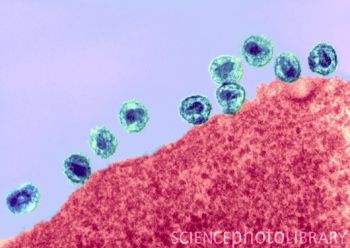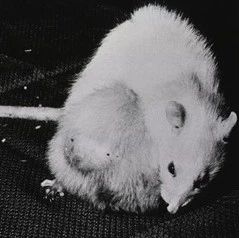导读:研究小组证实人工改造干细胞确实能够在活着的生物体中攻击被HIV感染的细胞,目前,他们正准备制造靶向HIV病毒不同部分的T细胞受体以便能够用于更多的基因相匹配的个人,若能开发成功,将能够校正人T细胞反应存在的缺陷,从而阻止HIV利用这种缺陷在被感染的人体内持续存在。

HIV病毒感染的细胞
美国加州大学洛杉矶分校的一个研究小组在PLoS Pathogens发表了题为“In Vivo Suppression of HIV by Antigen Specific T Cells Derived from Engineered Hematopoietic Stem Cells”的文章,首次证实人工改造干细胞确实能够在活着的生物体中攻击被HIV感染的细胞。
这项研究主要研究员、加州大学洛杉矶分校大卫•格芬医学院血液学与肿瘤学部门医学助理教授和加州大学洛杉矶分校艾滋病研究所成员Scott G. Kitchen称:“我们相信这项研究为潜在地使用这种方法在被感染的个人体内抵抗HIV感染打下基础,以期待它能够将体内的病毒全部清除。”
Kitchen和他的团队的研究人员所追求的目标是找到一种方法来遏制艾滋病毒,然后重建以及充分提高CTL的反应以消除体内的病毒。
早期工作中,他们研究了艾滋病病毒感染者来源的淋巴细胞,发现淋巴细胞有一个抗艾滋病毒的T细胞受体。
携带抗艾滋病毒的T细胞受体的淋巴细胞能够消除艾滋病毒感染的细胞,但他们发现CTLs的数量不足够以完全清除体内的艾滋病毒。
因此,为了克服这个问题,研究人员开展了目前这项研究,他们克隆抗艾滋病毒的T细胞,并用其通过基因工程将人造血干细胞(造血干细胞)改造成成熟的、能与淋巴细胞协同一起杀死艾滋病毒感染的细胞。
然后,他们把基因工改造过的干细胞植入实验小鼠体内的人体胸腺组织中。
如今,研究人员正准备制造靶向HIV病毒不同部分的T细胞受体以便能够用于更多的基因相匹配的个人。
不过,研究人员也注意到这项研究的潜在不足之处:在人源化小鼠中重建的人免疫细胞数量要比在人体中的较低,造成的后果就是小鼠的免疫系统只是大部分得到重建,而不是全部得到重建。因此,HIV可能在小鼠体内突变的速度要比人体内较慢。因此使用多种人工改造的T细胞受体可能是解决HIV病毒在人体中拥有潜在较高突变率的一种方法。
这些研究是开发出一种更加积极有效的方法的第一步,若能开发成功,将能够校正人T细胞反应存在的缺陷,从而阻止HIV利用这种缺陷在被感染的人体内持续存在。

 In Vivo Suppression of HIV by Antigen Specific T Cells Derived from Engineered Hematopoietic Stem Cells
In Vivo Suppression of HIV by Antigen Specific T Cells Derived from Engineered Hematopoietic Stem Cells
Scott G. Kitchen, Bernard R. Levin, Gregory Bristol, Valerie Rezek, Sohn Ki, Christian Aguilera-Sandoval, Arumugam Balamurugan4, Otto O. Yang Jerome A. Zack
The HIV-specific cytotoxic T lymphocyte (CTL) response is a critical component in controlling viral replication in vivo, but ultimately fails in its ability to eradicate the virus. Our intent in these studies is to develop ways to enhance and restore the HIV-specific CTL response to allow long-term viral suppression or viral clearance. In our approach, we sought to genetically manipulate human hematopoietic stem cells (HSCs) such that they differentiate into mature CTL that will kill HIV infected cells. To perform this, we molecularly cloned an HIV-specific T cell receptor (TCR) from CD8+ T cells that specifically targets an epitope of the HIV-1 Gag protein. This TCR was then used to genetically transduce HSCs. These HSCs were then introduced into a humanized mouse containing human fetal liver, fetal thymus, and hematopoietic progenitor cells, and were allowed to differentiate into mature human CD8+ CTL. We found human, HIV-specific CTL in multiple tissues in the mouse. Thus, genetic modification of human HSCs with a cloned TCR allows proper differentiation of the cells to occur in vivo, and these cells migrate to multiple anatomic sites, mimicking what is seen in humans. To determine if the presence of the transgenic, HIV-specific TCR has an effect on suppressing HIV replication, we infected with HIV-1 mice expressing the transgenic HIV-specific TCR and, separately, mice expressing a non-specific control TCR. We observed significant suppression of HIV replication in multiple organs in the mice expressing the HIV-specific TCR as compared to control, indicating that the presence of genetically modified HIV-specific CTL can form a functional antiviral response in vivo. These results strongly suggest that stem cell based gene therapy may be a feasible approach in the treatment of chronic viral infections and provide a foundation towards the development of this type of strategy.
文献链接:https://www.plospathogens.org/article/info%3Adoi%2F10.1371%2Fjournal.ppat.1002649






